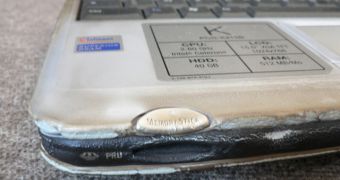Maybe some of you remember that back in 2012, HP had to pay a massive $425,000 / €311,766 in order to settle a claim saying the company consciously equipped their laptops with batteries which were prone to overheat or catch fire.
Acer, Dell or Samsung aren't strangers to this story either, but a new finding has the potential to make laptops safer.
Anyway, even if laptops bursting up into flames are not something you regularly hear about, you should be aware there are some risks (albeit very smalls) or lithium-ion batteries overheating and setting your laptop into inferno.
Even if such mishaps aren't a common threat to users, scientists at UNC Chapel Hill are already developing a solution, which might make laptop fires a thing of the past.
And as many great discoveries, researches have stumbled upon this solution while studying something else entirely. In this case, scientists came across a surprising replacement for only inherently flammable component of lithium-ion batteries, the electrolyte, after looking into a material that prevents material life to sticking to the bottom of ships.
The paper has been published in the Proceedings of the National Academy of Sciences and draws attention to recent lithium battery fires in Boeing 787 Dreamliners and Tesla Model S vehicles.
This solution is the first step in the creation of a new-gen of lithium-ion battery that handles high temperatures and doesn't spontaneously combust.
While conducting their marine life research, scientist discovered that PEPE has a similar chemical structure to the polymeric electrolyte from lithium-ion batteries. PEPE is not a new discovery and has been actively used on prompting industrial machinery to run at optimal levels.
“When we discovered that we could dissolve lithium salt in this polymer, that’s when we decided to roll with it. Most polymers don’t mix with salts, but this one did – and it was nonflammable. It was an unexpected results,” said one of the researchers.
The next step will be to find a way in improving battery cycle performance while integrating the material intro the commercial batter pack.

 14 DAY TRIAL //
14 DAY TRIAL //